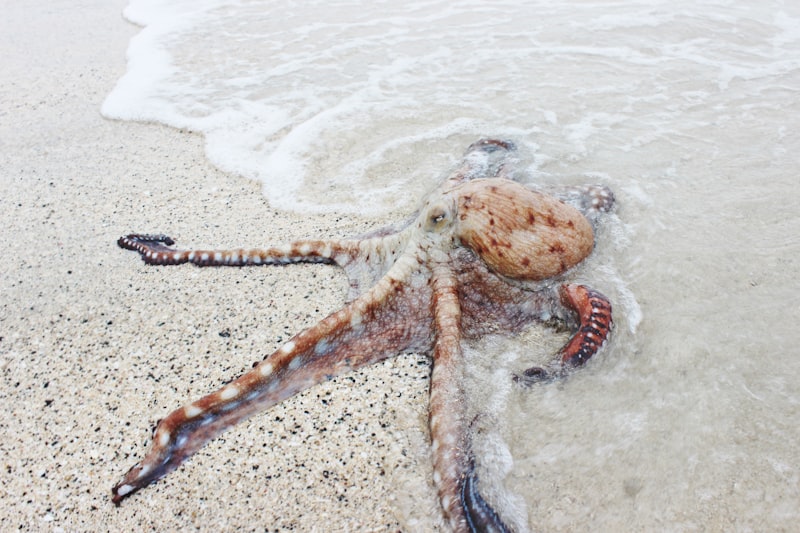Have you ever wondered about the mysterious creatures that lurk beneath the ocean waves? Enter the fascinating world of octopuses, where reality often surpasses imagination. These enigmatic cephalopods are masters of disguise, capable of changing their skin color and texture to blend seamlessly with their surroundings. Imagine a creature that can transform itself into a rocky outcrop or mimic the movements of other marine animals—all in the blink of an eye.
Octopuses possess not only camouflage skills but also remarkable intelligence. They navigate complex mazes, solve puzzles, and even exhibit play behavior, suggesting a level of cognitive ability akin to some vertebrates. Their brain-to-body ratio is among the highest of all invertebrates, highlighting their extraordinary mental prowess.
Beyond their cognitive abilities, octopuses are equipped with an array of fascinating adaptations. Their eight arms, lined with suckers that can taste and manipulate objects with precision, are instrumental in hunting prey and defending against predators. Some species have been observed using tools, such as coconut shells or discarded debris, to construct protective shelters—an impressive display of problem-solving skills.
Despite their mesmerizing traits, octopuses remain elusive and mysterious to scientists. Their ability to regenerate lost limbs and their unique biology, including three hearts and blue blood, continue to intrigue researchers worldwide. Each species, from the tiny blue-ringed octopus to the giant Pacific octopus, adds a new layer to our understanding of marine life.
In the depths of the ocean, where sunlight struggles to reach, the world of octopuses unfolds with its own tales of survival, adaptation, and intelligence. As we uncover more about these remarkable creatures, one thing becomes clear: the allure of the octopus lies not just in its physical capabilities but in its capacity to challenge our perceptions of life beneath the waves.
Masters of Disguise: How Octopuses Use Camouflage to Evade Predators
Ever wondered how octopuses manage to disappear right before your eyes? These incredible creatures are true masters of disguise, using camouflage techniques that astound scientists and confound predators alike.
Octopuses possess specialized skin cells called chromatophores, which contain pigments that can expand or contract rapidly, allowing them to change color in an instant. This ability isn’t just for show; it serves as a powerful defense mechanism against predators hunting them in the vast ocean depths.
Imagine you’re an octopus. Your skin is a canvas, and your chromatophores are the paintbrushes. When threatened, you don’t just turn red or blue like a traffic light; you transform into the very seafloor you rest upon, mimicking its texture and coloration with astonishing precision. This mimicry isn’t random; it’s a deliberate adaptation honed through millions of years of evolution.
But color isn’t the only trick up their sleeve—octopuses can also change the texture of their skin to match their surroundings. By altering the bumps, spikes, and even the softness of their skin, they achieve a level of camouflage that’s akin to a chameleon blending into a tree bark. This dual ability to change both color and texture makes them virtually invisible to predators and allows them to strike when least expected.
Their camouflage isn’t just for defense, though. Octopuses are also skilled hunters, using their disguise to sneak up on unsuspecting prey. Imagine a lion stalking its prey in the savannah—except this lion can seamlessly blend into the grass itself. That’s the kind of advantage octopuses gain from their camouflage prowess.
Brainy Behemoths: Unveiling the Intelligence of Octopuses
Did you know that beneath the waves, a creature with remarkable intelligence lurks? Enter the world of octopuses, where mystery and intellect intertwine in astonishing ways. These marine marvels are not just masters of camouflage; they possess an intelligence that rivals some of the smartest animals on land.
Octopuses, with their impressive problem-solving skills and adaptability, captivate scientists and sea enthusiasts alike. Their brains, while different from ours, showcase incredible complexity. Imagine an animal capable of navigating mazes, opening jars to retrieve food, and even recognizing individual humans! Such feats highlight their cognitive prowess and raise intriguing questions about the evolution of intelligence in the ocean depths.
What sets octopuses apart is their ability to learn and adapt rapidly. They can use tools, a skill once thought exclusive to primates. For instance, some species have been observed carrying coconut shells to use as protective shelters—a behavior that showcases not only innovation but also planning.
Beyond their cognitive abilities, octopuses exhibit personalities that vary from individual to individual. Some are bold and explorative, while others are more cautious and observant. This diversity adds another layer to their fascinating behavior and challenges our understanding of animal consciousness.

In the realm of marine biology, studying octopuses isn’t just about unraveling their intelligence; it’s about exploring the mysteries of the ocean’s depths. Each discovery—whether it’s a new hunting technique or a surprising social interaction—offers a glimpse into a world where brainpower takes on a different form.
As we continue to delve deeper into the secrets of these brainy behemoths, one thing remains clear: octopuses are not just creatures of the sea; they are champions of ingenuity and wonder.
Incredible Adaptations: The Unique Abilities of Octopuses Revealed
One of the most jaw-dropping abilities of octopuses is their camouflage prowess. Imagine being able to blend seamlessly into your surroundings just by altering the color and texture of your skin. Octopuses achieve this feat using specialized cells called chromatophores, which expand or contract to display different colors. This adaptation isn’t just for show—it helps them evade predators and sneak up on prey with astonishing stealth.
But that’s not all. Octopuses are also masters of escape. Despite lacking bones, these creatures are incredibly flexible due to their soft bodies and can squeeze through tiny openings with ease. They use their dexterous arms to navigate complex environments and even dismantle traps set by researchers in captivity. It’s like having a real-life Houdini of the ocean!
Speaking of arms, each of an octopus’s eight appendages is lined with hundreds of suction cups, each equipped with sensors that allow them to taste and touch. This tactile sense is crucial for exploring and manipulating objects in their environment. Just imagine having such sensitive fingertips that you could taste what you touch!
Furthermore, octopuses possess highly developed brains capable of complex behaviors. They can solve puzzles, unscrew lids to retrieve food, and even learn by observation. This cognitive ability challenges the notion that intelligence is limited to vertebrate animals, showcasing the incredible diversity of adaptive strategies in the animal kingdom.
From Venomous Bites to Ink Clouds: Secrets of Octopus Defense Mechanisms
One of the most striking defenses of octopuses is their ability to deliver venomous bites. Their beak-like mouth contains a small, sharp structure capable of injecting venom into prey or predators alike. This venom can immobilize smaller prey and deter larger predators, ensuring the octopus’s safety.
Another remarkable defense mechanism is the famous ink cloud. When threatened, an octopus releases a dark, ink-like substance into the water. This cloud serves multiple purposes: it acts as a visual smokescreen, confusing predators by obscuring the octopus’s escape route. Additionally, the ink contains chemicals that interfere with the predator’s sense of smell, further aiding the octopus in evading capture.
Beyond physical defenses, octopuses also possess incredible camouflage abilities. They can change their skin color and texture to blend seamlessly with their surroundings, making them virtually invisible to both prey and predators. This remarkable skill allows them to hide in plain sight, avoiding detection until they decide to strike or retreat.
Interestingly, some species of octopuses exhibit mimicry as a defense tactic. They can mimic other animals, such as toxic flatfish or lionfish, to deter potential predators. This mimicry relies on their ability to contort their bodies and alter their color patterns rapidly, creating a convincing impersonation that warns predators of potential danger.

Octopuses employ a suite of sophisticated defense mechanisms that highlight their adaptability and survival instincts in the challenging oceanic world. From venomous bites that incapacitate prey to ink clouds that confuse predators, these strategies underscore the evolutionary brilliance of these cephalopods. Their ability to camouflage and mimic further enhances their survival chances, showcasing the marvels of nature’s adaptation at its finest.
Shape-Shifters of the Sea: The Astonishing Morphing Skills of Octopuses
Have you ever wondered about creatures that seem to belong in a world of magic rather than the ocean depths? Octopuses are among those mystical beings, known not only for their intelligence but also for their incredible ability to change shape and color at will. These shape-shifters of the sea possess a remarkable skill called cephalopod skin adaptation, which allows them to blend seamlessly with their surroundings or mimic other animals.
Imagine encountering an octopus that can transform its appearance to look like a rock on the ocean floor or a clump of seaweed. This camouflaging ability isn’t just about color; it involves altering the texture of their skin to match their environment perfectly. This skill isn’t just for hiding; it’s also used for hunting and avoiding predators, making octopuses masters of deception in the underwater world.
But their morphing skills don’t stop at camouflage. Octopuses can also change their shape dramatically. They can squeeze through tiny crevices or flatten themselves to escape tight spots, showing off their incredible flexibility. This ability comes from their lack of bones and a unique muscular structure that allows them to manipulate their body shape almost like a liquid.
How do they do it? Octopuses have thousands of specialized cells in their skin called chromatophores, which contain pigments. By expanding or contracting these cells, octopuses can change the color and pattern of their skin in milliseconds. Additionally, they can control iridophores and leucophores to manipulate light reflection and create shimmering effects, adding another layer of disguise to their camouflaging tactics.
In nature, few creatures can match the octopus’s ability to adapt to its environment so swiftly and effectively. It’s a testament to millions of years of evolution honing their survival skills in the ever-changing oceans. So next time you marvel at the ocean’s beauty, remember the shape-shifters of the sea—the astonishing octopuses—masters of disguise and adaptation.
Hidden Talents: The Artistry of Octopus Construction and Tool Use
Did you know that octopuses are not only masters of camouflage and intelligence but also skilled builders and tool users? These fascinating creatures exhibit a remarkable ability to construct intricate structures and utilize tools in their underwater habitats. Unlike many other marine animals, octopuses are capable of manipulating objects with incredible dexterity, thanks to their flexible tentacles and highly developed nervous system.
One of the most astonishing feats of octopus intelligence is their construction of shelters using various materials found on the ocean floor. They gather rocks, shells, and even discarded human artifacts to create protective dens where they can hide from predators or rest undisturbed. This behavior showcases not only their adaptability but also their strategic thinking in using available resources effectively.
Furthermore, octopuses have been observed using tools in the wild, a behavior once thought to be exclusive to humans and a few other species. They employ coconut shells, stones, and even discarded bottles as tools to aid in their foraging and protection. For example, some octopuses carry coconut shells and use them as portable shelters, cleverly camouflaging themselves while on the move.
Scientists believe that these behaviors are not instinctual but learned through observation and trial-and-error. Each octopus develops its unique techniques for building and tool use, adapting them to suit their individual needs and environments. This adaptability underscores their intelligence and problem-solving skills, making them intriguing subjects of study in marine biology and animal cognition.
The artistry of octopus construction and tool use reveals a hidden world of intelligence and ingenuity beneath the waves. By understanding how these creatures manipulate their environment, scientists gain valuable insights into the evolution of intelligence and adaptive behavior in non-human animals. Octopuses continue to surprise and inspire us with their remarkable abilities, challenging our understanding of what it means to be intelligent in the animal kingdom.
Frequently Asked Questions
What is the lifecycle and reproduction process of octopuses?
Learn about the lifecycle and reproduction process of octopuses, including details on their short lifespan, complex mating behaviors, and unique reproductive strategies such as egg laying and parental care. Explore how octopuses navigate through distinct life stages from hatching to adulthood, adapting to various marine environments.
How do octopuses camouflage themselves in different environments?
Learn how octopuses use specialized skin cells called chromatophores, iridophores, and leucophores to change color and texture, allowing them to blend seamlessly into various backgrounds for camouflage.
What are some unique adaptations of octopuses for survival?
Discover how octopuses have evolved unique adaptations for survival in their marine habitats. Learn about their camouflage abilities, including color-changing skin and texture mimicry, which help them evade predators and catch prey. Explore their exceptional intelligence and problem-solving skills that enable them to navigate complex environments and escape threats effectively.
How intelligent are octopuses compared to other animals?
Discover how octopuses rank in intelligence compared to other animals with our concise FAQ. Get insights into their cognitive abilities and unique behaviors.
What are some curious behaviors exhibited by octopuses?
Discover fascinating behaviors of octopuses, such as their ability to camouflage instantly, solve puzzles to obtain food, use tools for protection, and even engage in playful interactions with objects.


